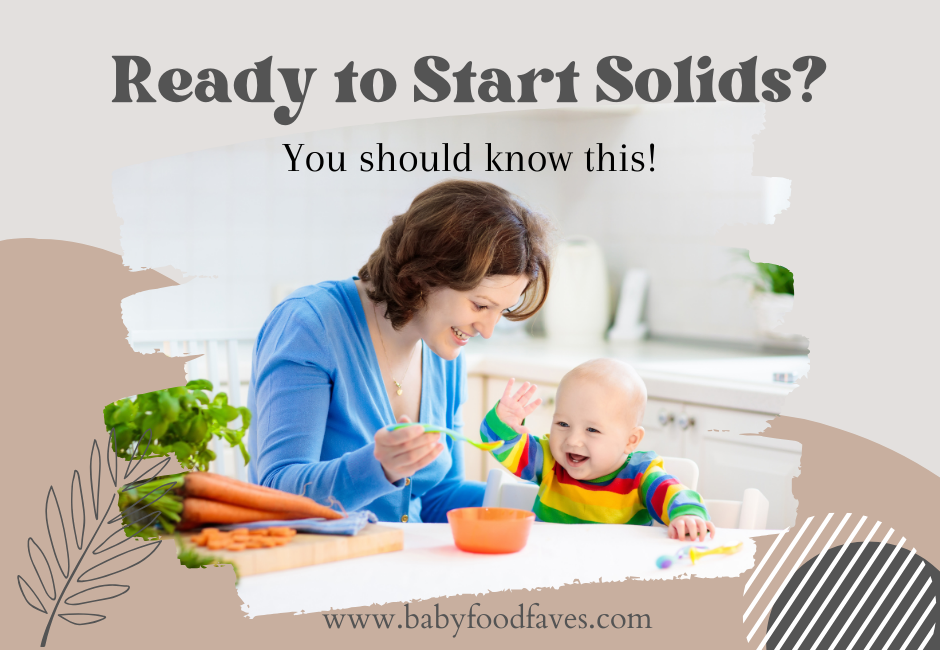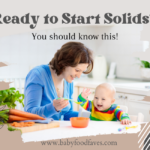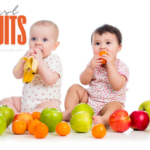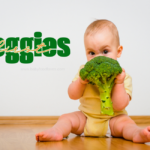Before my little one arrived, I read everything I could about introducing solid foods. I wanted to know the right methods to start with, when to introduce different foods, how to make mealtime fun, and what would set my baby up for healthy eating habits. By the time my daughter, Emma, was approaching 6 months, I felt confident and ready to begin the journey of starting solids.
Now, looking back, I’m happy to say my plan worked. Emma is a great eater, not picky at all, and enjoys a wide variety of foods. In this article, I’m sharing what I learned along the way—information that you’d typically find in expensive guides, but I’m offering it here for free. I hope my experience and the tips I’ve gathered can help you navigate this exciting milestone with confidence.
Table of Contents
- What are the Reasons to Start Solid Foods Before 6 Months
- Key Signs Your Baby is Ready to Start Solid Foods
- Choosing the Right Solid Food for Babies
- Methods to Start Solid Foods
- Tips for a Great Start with Solid Foods
- Essential Nutrients that Babies Need
- Safety and Hygiene Tips when Starting Solids
- Tips for Preparing Foods for Your Baby:
- Texture Progression for Solid Foods
- When and How to introduce allergens
- Tools You Will Need to Get Started With Solid Foods
- FAQ – Frequently Questions and Concerns about Introducing Solid Foods
Disclosure
The advice shared here is based on the recommendations from trusted health organizations like the American Academy of Pediatrics (AAP) and the World Health Organization (WHO). It’s important to note that these guidelines apply to babies born at term. If your baby was born prematurely, the timing and approach to introducing solids may be different, so be sure to consult with your pediatrician.
Health experts recommend that babies be fed exclusively breast milk or formula for the first 6 months. Even after introducing solids, breast milk or formula should remain your baby’s primary source of nutrition until they’re eating three balanced meals a day (this normally happens at around 8 months). Introducing solid foods is an exciting milestone that helps babies develop chewing and swallowing skills. It also offers an opportunity to introduce potential allergens early, which may reduce the risk of allergies later on.
Before I continue, it’s important to recognize that determining if your baby is ready for solid foods involves looking for key signs of readiness. This article outlines these indicators to help you decide when to begin this exciting new stage of your baby’s development
What are the Reasons to Start Solid Foods Before 6 Months
While most health experts recommend starting solid food around 6 months, some may suggest starting between 4 to 6 months, depending on your baby’s development. However, it is important to note that babies younger than 4 months should avoid certain foods and juices to prevent potential health issues. Here are some signs to watch for when considering introducing solids:
Developmental Readiness: Some babies show they are ready for solids before 6 months. Signs include good head control, the ability to sit with little support, and showing interest in food by reaching for it or opening their mouths when food is offered.
Increased Appetite: If your baby seems hungry even after regular breastfeeding or formula feeding, starting solids might help meet their nutritional needs.
Nutritional Needs: Some babies may need extra nutrients that they can’t get enough of from breast milk or formula alone, like iron, which starts to deplete around 4-6 months.
Growth Spurts: During growth spurts, babies might need more calories than they can get from milk, and solids can help.
Medical Recommendations: Sometimes, doctors may suggest starting solids earlier due to specific health conditions.
Cultural Practices: Different cultures have their own traditions about when to start solids, sometimes beginning earlier based on family customs.
Feeding Issues: Babies who struggle to gain weight may benefit from starting solids sooner.
If you’ve noticed these signs in your baby and you both feel ready to start solids, then you’re on the right track. Remember, you need to be familiar with choking hazards, gagging, and ready to invest time in this new milestone. Whether you feel ready or are still unsure, I have an article on introducing vegetables and another on introducing fruits. Be sure to take a look at both of them for more guidance!
Key Signs Your Baby is Ready to Start Solid Foods
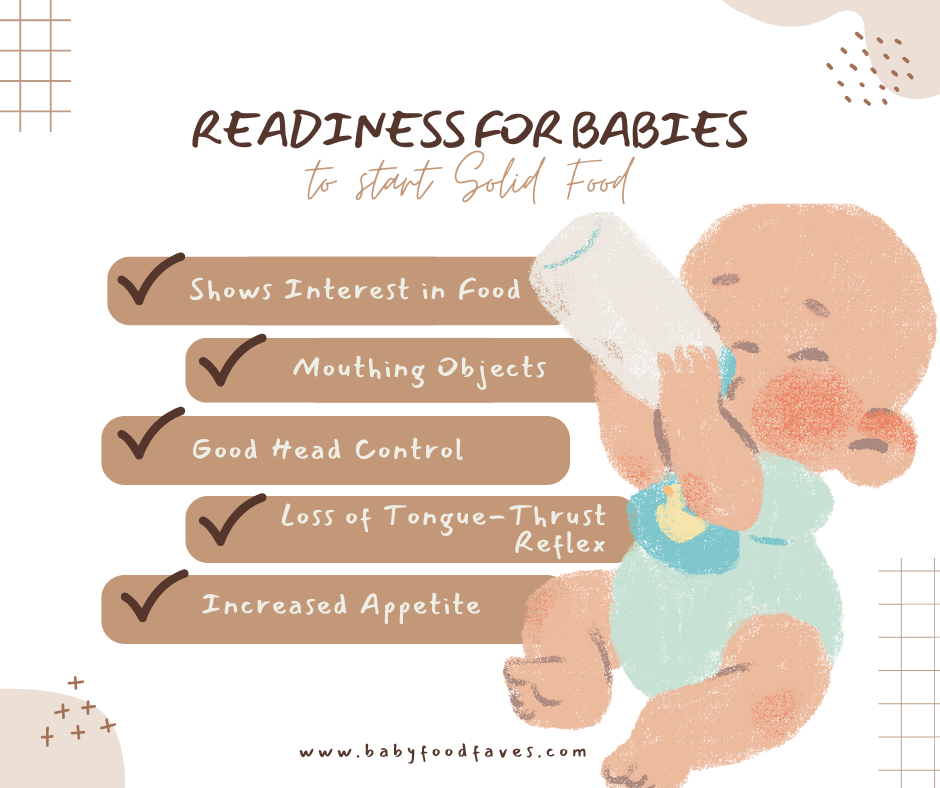
The AAP recommends introducing foods around 6 months. By this age, most babies are ready to try something other than breast milk or formula. Here are some signs that your baby might be ready, keet in mind that individual readiness can vary:
Mouthing Objects: If your baby puts toys and other objects in their mouth, they are exploring different textures and tastes.
- Good Head Control: Your baby should be able to hold their head up steadily and sit up without support. This is super important for safe eating.
Loss of Tongue-Thrust Reflex: This reflex makes babies push food out of their mouths. It usually goes away around 3-4 months, which is a sign they can handle solid food.
Increased Appetite: If your baby seems hungrier than usual after their normal amount of milk, it may be time to try solids.
- Shows interest in Food: If your baby watches you eat, reaches for your food, or opens their mouth when you offer them food, they may be ready for solids.
Choosing the Right Solid Food for Babies
With so many options available, choosing the right solid food for your baby can be overwhelming. Here are some tips to help you make the right choice:
Start with Single-Ingredient Purees: Begin with simple, single-ingredient purees like iron-fortified rice cereal or pureed fruits and vegetables. This helps you monitor for any food allergies.
Choose Soft, Easy-to-Digest Foods. Foods like mashed bananas or avocados are gentle on your baby’s digestive system and easy to swallow.
Avoid Adding Sugar, Salt, or Honey. Babies don’t need added sugars or salts, and honey should be avoided until after the first year due to the risk of botulism.
Opt for Breast Milk or Formula. Continue to use breast milk or formula as the primary source of nutrition until around 12 months. Solid foods should complement, not replace, these essential nutrients.
Remember to always check with your pediatrician before introducing new foods to ensure they are safe and suitable for your baby.
Methods to Start Solid Foods
There are different ways to introduce solid foods to your baby. Here are the most common methods:
1.Traditional Weaning:
Purees First: Start with single-grain cereals or pureed fruits and vegetables. Gradually introduce a variety of baby solid foods over time. Introduce one new food at a time and wait a few days before adding another to check for allergies.
2. Baby-Led Weaning (BLW):
Self-Feeding: Instead of purees, offer soft, age-appropriate baby finger foods that the baby can grasp and explore. This method encourages independence and helps babies experience different textures. Soft steamed vegetables, ripe fruits, and small pieces of bread are great choices.
3. Combination Weaning:
Mix of Both Methods: Start with purees and gradually transition to finger foods. This way, you can provide a variety of textures while still controlling what foods are introduced.
Each method has its advantages, and you can choose one based on your baby’s readiness and your family’s lifestyle. Regardless of the method, ensure safety and watch for any allergy symptoms.
Tips for a Great Start with Solid Foods
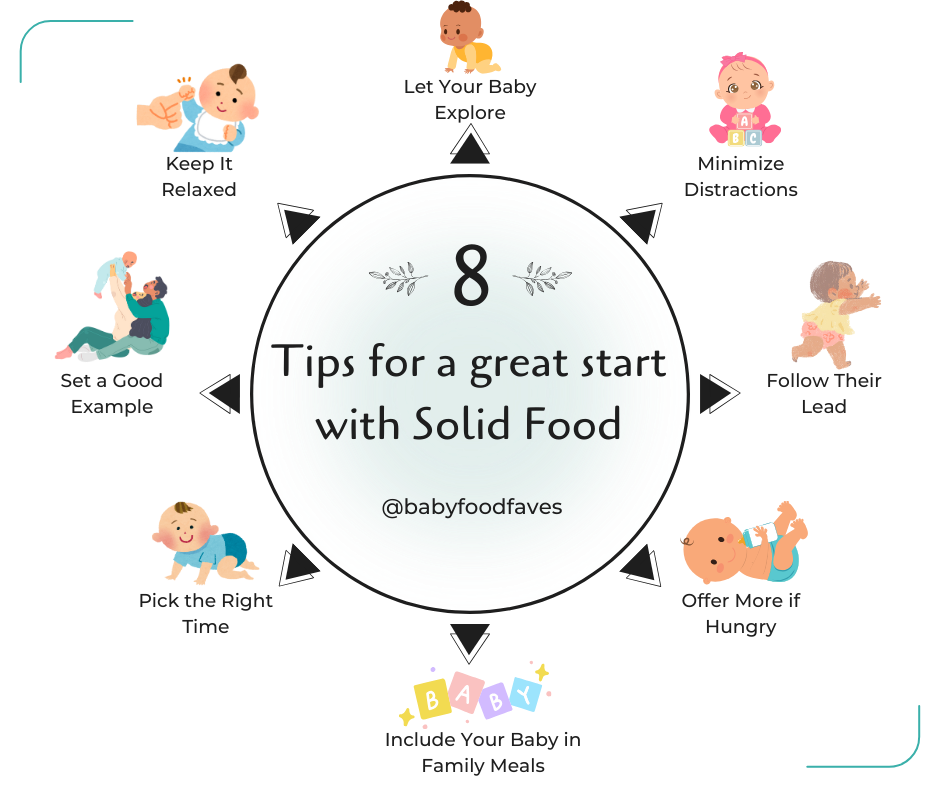
Let Your Baby Explore: Encourage your baby to touch and play with their food, and allow them to try feeding themselves when they’re ready. Around 9 months, many babies want to take the lead and may refuse to be spoon-fed.
Minimize Distractions: Turn off the TV and put away toys to help your baby focus on their food. This can help them develop a better relationship with eating.
Follow Their Lead: Stop feeding if your baby shows signs of not being interested. Babies know how much they need to eat, so avoid holding the spoon in front of their mouth for too long or forcing them to take bites. It is normal for babies to refuse to eat solid food due to unfamiliar tastes and textures.
Offer More if Hungry: If your baby seems still hungry, offer more food. Their appetite can vary from day to day, so it’s important to be flexible.
Include Your Baby in Family Meals: Try to make mealtime a family event. Studies show that babies and young children who eat with their families tend to eat better and are less picky.
Pick the Right Time: Choose a time when your baby is calm and not too tired or hungry—mid-morning or early afternoon is often ideal.
Keep It Relaxed: Try to keep mealtime stress-free. If your baby isn’t interested in eating, don’t worry—try again later. The goal is to make mealtime a positive, enjoyable experience.
Bonus Tips:
Nutritional Considerations: Iron-rich foods are important since babies’ iron stores start to decrease around 6 months. Pureed meats and fortified cereals are good choices.
Safety Tips: Always keep an eye out for choking hazards, and avoid honey until after the first year due to the risk of botulism.
Essential Nutrients that Babies Need
As your baby grows, they require a variety of nutrients to support their development. Solid foods can provide essential nutrients like iron, zinc, and protein. Here are some key nutrients your baby needs:
Iron: Found in iron-fortified cereals, pureed meats, and vegetables. Iron is crucial for your baby’s brain development and overall growth.
Zinc: Found in pureed meats, poultry, and fish. Zinc supports the immune system and helps with cell growth.
Protein: Found in pureed meats, poultry, fish, and legumes. Protein is essential for building and repairing tissues.
Calcium: Found in breast milk, formula, and fortified cereals. Calcium is vital for developing strong bones and teeth.
When starting solid foods, make sure to offer a variety of nutrient-rich foods to support your baby’s growth and development. A balanced diet will help ensure they get all the essential nutrients they need.
Safety and Hygiene Tips when Starting Solids
When introducing solid foods, it’s crucial to prioritize safety and hygiene to prevent the risk of foodborne illness. Here are some tips to follow:
Always Wash Your Hands: Before preparing and feeding your baby, wash your hands thoroughly to prevent the spread of germs.
Clean and Sanitize Utensils: Ensure all utensils, equipment, and surfaces are clean and sanitized before use.
Store Food Properly: Keep food at the correct temperature and discard any expired or spoiled food to avoid foodborne illnesses.
Never Leave Your Baby Alone While Eating: Always supervise your baby during mealtime to prevent choking and ensure they are eating safely.
Be Aware of Choking Hazards: Avoid common choking hazards like hot dogs, raw vegetables, and small, hard foods. Cut foods into small, manageable pieces to make them safer for your baby to eat.
By following these safety and hygiene tips, you can help ensure a safe and healthy eating experience for your baby.
Tips for Preparing Foods for Your Baby:
Avoid Added Salt and Sugar. Since babies’ kidneys are not fully developed and their taste buds are sensitive, it’s best to skip adding salt and sugar to their food.
Remove Skin, Fat, and Bones: Ensure meat, poultry, and fish are free from skin, fat, and bones before cooking.
Mix Cereals or Grains. Combine cereals or mashed grains with breast milk, formula, or water to create a smooth texture that your baby can easily swallow.
Cook Until Tender. Make sure foods are cooked until tender enough to be easily mashed with a fork.
Mash or Puree Thoroughly. Fruits, vegetables, and other foods should be mashed or pureed until they reach a completely smooth consistency.
Use a Food Processor. A good food processor or blender is essential for achieving a smooth consistency for purees.
Soften Hard Fruits and Veggies. Cook hard fruits and vegetables like apples and carrots to soften them for easier mashing or pureeing.
Cut Cylindrical Foods Safely. For foods like hot dogs, sausages, or string cheese, cut them into short, thin strips instead of round pieces to avoid airway blockage.
Remove Seeds or Pits. Make sure to remove seeds or pits from fruits and cut them into small, manageable pieces.
Prepare Whole Grains Properly. Cook whole grains like wheat, barley, or rice, then finely grind or mash them to make them easy for your baby to digest.
Prepare in Batches. Cook and puree food in larger batches, then freeze portions in ice cube trays for easy future use.
Cut Soft Foods into Small Pieces. : Reduce the risk of choking by cutting soft foods into small chunks or thin slices
Slice Small Round Foods. Cut small round foods like grapes, cherries, berries, and tomatoes into smaller pieces to make them safer for your baby to eat.
Hydration is Key: Always offer water with meals once solids are introduced to help with digestion and hydration.
Texture Progression for Solid Foods
As your baby becomes accustomed to eating solid foods, it’s essential to introduce a variety of textures to promote healthy eating habits. Here’s a general texture progression to follow:
Pureed Foods (around 6 months): Start with smooth purees to help your baby get used to the idea of eating solid foods.
Mashed Foods (around 7-8 months): Gradually introduce mashed foods to add more texture and help your baby develop chewing skills.
Soft, Finger Foods (around 8-10 months): Offer soft, easy-to-grasp finger foods like small pieces of steamed vegetables or ripe fruits to encourage self-feeding.
Chopped, Table Foods (around 12 months): By this age, your baby can handle more complex textures and can start eating small, chopped pieces of the same foods the rest of the family is eating.
Remember to always supervise your baby during mealtime and to chop foods into small, manageable pieces to reduce the risk of choking.
When and How to introduce allergens
Introducing common allergens to your baby’s diet is an important step in reducing the risk of food allergies later in life. These allergens include foods such as cow’s milk, eggs, peanuts, tree nuts, soy, wheat, fish, shellfish, and sesame. Current guidelines recommend introducing potentially allergenic foods around 6 months of age, as early introduction may help the immune system tolerate these foods.
For example, parents are advised to introduce peanut products in the form of peanut butter or peanut powder in small, controlled amounts, and under careful supervision, especially if there is a family history of allergies. It’s important to introduce one allergen at a time and monitor for any reactions such as rashes, swelling, or respiratory issues. If no reactions occur, gradually increase the quantity over time. This method not only helps in identifying any potential allergies early but also aids in building tolerance.
Always consult with your pediatrician, especially if your baby has a family history of allergies or conditions like eczema.
Tools You Will Need to Get Started With Solid Foods
Starting your little one on solid foods is an exciting milestone, and having the right tools can make the process smoother and more enjoyable for both you and your baby. Here are the essential tools you’ll need:
- High Chair: A sturdy high chair with a safety harness gives your baby a safe place to eat. Check out my article about best high-chairs for babies in 2025.
- Baby Spoons: Soft, shallow spoons designed for babies make feeding easier and are gentle on their gums.
- Bowls and Plates: Non-slip, divided plates and bowls help keep different foods separate and are easy to clean.
- Bibs: Waterproof or easy-to-clean bibs protect your baby’s clothes from spills.
- Sippy Cups: Look for spill-proof designs with handles to help your baby learn to drink from a cup. Best sippy cups HERE.
- Blender or Food Processor: Useful for making homemade purees from fruits and vegetables. Soft food is essential for helping babies learn to bite, chew, and swallow.
- Steamer Basket: Steaming fruits and veggies helps keep nutrients while making them soft enough for your baby.
- Storage Containers: Small, airtight containers are great for storing homemade baby food.
- Feeding Mats: Placing a mat under the high chair makes cleanup easier.
- Freezer Trays: These allow you to freeze small portions of pureed foods for quick meals.
- Handheld Masher: Perfect for mashing fruits and vegetables quickly.
- Baby Wipes: Handy for quick cleanups after meals.
- First Aid Supplies: Keep basic first aid supplies nearby in case of minor accidents.
FAQ – Frequently Questions and Concerns about Introducing Solid Foods
How many meals should I give my baby at 6 months?At 6 months, start by offering solid foods once or twice a day, in addition to breast milk or formula. As your baby gets used to solids, you can gradually increase to three meals a day. Focus on a variety of foods and textures to help them explore different flavors.
Can I give my baby water once I start solid food?Yes, you can begin offering small amounts of water once you start introducing solids. Water helps with digestion and keeps your baby hydrated, especially in warmer weather.
How much should a 6-month-old baby eat?At 6 months, portion sizes can vary, but a good starting point is about 1 to 2 tablespoons of food per meal. As your baby becomes more comfortable with eating, you can gradually increase the portion sizes. Pay attention to your baby’s hunger cues and let them guide how much they want to eat. When planning your baby’s food, ensure you introduce new tastes gradually while maintaining their primary nutrition from breast milk or formula.
Can I start with store-bought baby food?Yes, starting with store-bought baby food is perfectly fine. Many parents find it convenient and safe. Look for high-quality, organic options without added sugars or preservatives. Just remember to introduce one new food at a time to check for allergies.
Keep in Mind: Each baby develops at their own pace, and these signs are just general guidelines. It’s important to consult your pediatrician before starting solids, especially if you’re thinking about beginning before 6 months.
I would love to hear about your experience—together, we can help other parents make informed decisions about introducing solids to their little ones.

